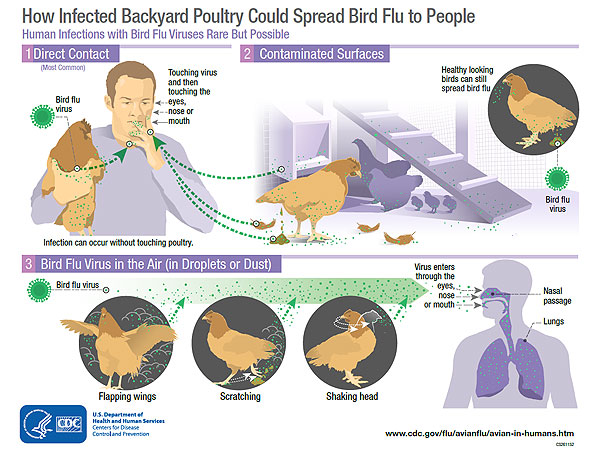Archived – Outbreaks of North American Lineage Avian Influenza Viruses
Outbreaks caused by avian influenza viruses, including both highly pathogenic avian influenza (HPAI) and low pathogenic avian influenza (LPAI) occur In U.S. domestic poultry from time to time.
For example,
- HPAI H5 viruses (H5N1, H5N2 and H5N8) were detected in 21 U.S. states from December 2014 to mid-June 2015.
- In January 2016, HPAI and LPAI H7N8 viruses were reported in Dubois County, Indiana.
- And, in early March 2017, HPAI and LPAI H7N9 viruses were reported in Tennessee and subsequently in Alabama, Kentucky and Georgia.
These outbreaks were caused by North American lineage viruses or North American reassortant viruses that are different from Asian H5N1 and Asian H7N9 viruses that have caused human infections resulting in serious illness and death in other parts of the world. Asian H5N1 and Asian H7N9 viruses have not been detected in people or birds in the United States.
North American lineage avian influenza viruses have very rarely infected people. CDC considers the risk to the general public from North American avian influenza viruses to be low; however, because other avian influenza viruses have infected people, it is possible that human infections with these viruses could occur. Human infections with other avian influenza viruses have occurred after close and prolonged contact with infected birds or the excretions/secretions of infected birds (e.g., droppings, oral fluids). Risk is dependent on exposure. People with close or prolonged unprotected contact with infected birds or contaminated environments are likely to be at greater risk of infection.
CDC Recommendations & Resources
The Centers for Disease Control and Prevention is the lead Federal agency for the human health response.
- CDC has long-standing recommendations for the public on this topic. As a general precaution, people should avoid wild birds and observe them only from a distance; avoid contact with domestic birds (poultry) that appear ill or have died; and avoid contact with surfaces that appear to be contaminated with feces from wild or domestic birds.
- For people with exposures to birds infected with avian influenza viruses or potentially contaminated environments, CDC recommends the same protective measures for all outbreaks of North American lineage avian influenza viruses in birds. This is consistent with guidance for exposure to novel influenza viruses with the potential to cause severe disease in humans.
- For people responding to avian influenza outbreaks, CDC has developed materials for avian influenza outbreak responders,
- CDC also has developed materials for and people who live near affected areas who might have questions or concerns about this situation .
- As a general precaution, people should avoid wild birds and observe them only from a distance; avoid contact with domestic birds (poultry) that appear ill or have died; and avoid contact with surfaces that appear to be contaminated with feces from wild or domestic birds.
- People who have had contact with infected bird(s) should monitor their own health for possible symptoms (for example, conjunctivitis, or flu-like symptoms).
- People who have had contact with infected birds may also be given influenza antiviral drugs preventatively.
- Health care providers evaluating patients with possible avian influenza infection should notify their local or state health departments which in turn should notify CDC.
- CDC will provide case-by-case guidance.
- There is no evidence that any human cases of avian influenza have ever been acquired by eating properly cooked poultry products.
- CDC will update the public as new information becomes available.



